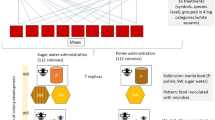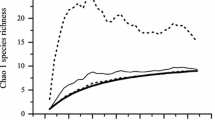Summary
The substrate of newly constructedMacrotermes fungus combs is inoculated from the start with viableTermitomyces conidia (asexual spores) which guarantee fast proliferation of the symbiotic fungus. The substrate is vegetable matter which has passed rapidly through the intestine of the young workers which are comb-builders and nurses. These ingest the vegetable matter which has been collected by the foragers and also feed on the nutrient enriched nodules produced by the fungus. These nodules contain the adaptive gut-resistant conidia which are mixed with the intestinal substrate on this pathway.
Resume
ChezMacrotermes le substrat des meules à champignon nouvellement formées est inoculé dès le début par des conidies viables deTermitomyces (spores asexuées) qui garantissent la prolifération accélérée du champignon symbiotique. Le substrat est de la matière végétale ayant traversé rapidement l'intestin des jeunes ouvriers, c'est-à-dire les constructeurs de meules et les nourrices. Ces insectes ingèrent la matière végétale recueilie par les fourrageurs et se nourrissent aussi des mycotêtes nutritives produites par le champignon. Ces mycotêtes contiennent les conidies qui sont adaptées à résister au passage à travers l'intestin où elles se mélangent avec le substrat.
Similar content being viewed by others
References
Badertscher S., Gerber C., Leuthold R.H., 1983. — Polyethism in food supply and processing in the termite colonies ofMacrotermes subhyalinus.Behav. Ecol. Sociobiol., 12, 115–119.
Batra L.R., Batra S.W.T., 1979. — Termite- fungus mutualism, in:Insect-Fungus Symbiosis (ed. Batra L.R.), John Wiley and Sons, New York, pp. 117–163.
Billen J., Leuthold R.H., Joye L., 1987. — Salivary gland morphology related to polyethism in the termiteMacrotermes bellicosus, in:Chemistry and Biology of Social Insects eds. Eder J. and Rembold H.), J. Peperny, Munich, p. 415.
Billen J., Joye J., Leuthold R.H., 1989. — Fine structure of the labial gland inMacrotermes bellicosus (Isoptera, Termitidae).Acta Zool., 70, in press.
Dixon P.A., 1983. — Reproductive capacity ofTermitomyces striatus.Trans. Brit. Mycol. Soc., 80, 131–139.
Gerber C., Badertscher S., Leuthold R.H., 1988. — Polyethism inMacrotermes bellicosus.Insectes Soc., 35, 226–240.
Grassé P.P., 1978. — Sur la véritable nature et le rôle des meules à champignons construites par les termitesMacrotermitinae (Isoptera, Termitidae).C.R. Acad. Sci., Paris,287D, 1223–1226.
Heim R., 1977. —Termites et champignons, Société nouvelle d'Editions Boubée, Paris.
Johnson R.A., 1981. — Colony development and establishment of the fungus combs inMicrotermes sp. nr. usambaricus (Sjöstedt) from Nigeria.Insectes Soc., 28, 3–12.
Johnson R.A., Thomas R.J., Wood T.G., 1981. — The inoculation of the fungus comb in newly founded colonies of some species of theMacrotermitinae (Isoptera) from Nigeria.J. Nat. Hist., 15, 751–756.
Sands W.A., 1956. — Some factors affecting the survival ofOdontotermes badius (Hav.).Insectes Soc., 3, 531–536.
Sands W.A., 1960. — The initiation of fungus comb construction in laboratory colonies ofAncistrotermes guineensis (Silvestri).Insectes Soc., 7, 251–263.
Sieber R., Leuthold R.H., 1981. — Behavioural elements and their meaning in incipient laboratory colonies of the fungus-growing termiteMacrotermes michaelseni (Isoptera, Macrotermitinae).Insectes Soc., 28, 371–382.
Sieber R., 1983. — Establishment of fungus comb in laboratory colonies ofMacrotermes michaelseni andOdontotermes montanus (Isoptera, Macrotermitinae).Insectes Soc., 30, 204–209.
Thomas R.J., 1987a. — Distribution ofTermitomyces Heim and other fungi in the nests and major workers ofMacrotermes bellicosus (Smeathman) in Nigeria.J. Soil Biochem., 19, 329–333.
Thomas R.J., 1987b. — Distribution ofTermitomyces and other fungi in the nests and major workers of several NigerianMacrotermitinae.J. Soil Biochem., 19, 335–341.
Weber N.A., 1979. — Fungus-culturing by ants, inInsect-Fungus Symbiosis (ed. Batra L.R.), John Wiley and Sons, New York, pp. 77–116.
Author information
Authors and Affiliations
Rights and permissions
About this article
Cite this article
Leuthold, R.H., Badertscher, S. & Imboden, H. The inoculation of newly formed fungus comb withTermitomyces inMacrotermes colonies (Isoptera, Macrotermitinae). Ins. Soc 36, 328–338 (1989). https://doi.org/10.1007/BF02224884
Received:
Accepted:
Issue Date:
DOI: https://doi.org/10.1007/BF02224884




